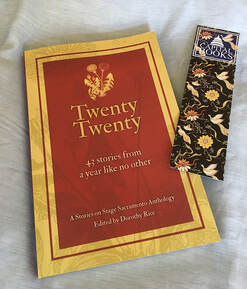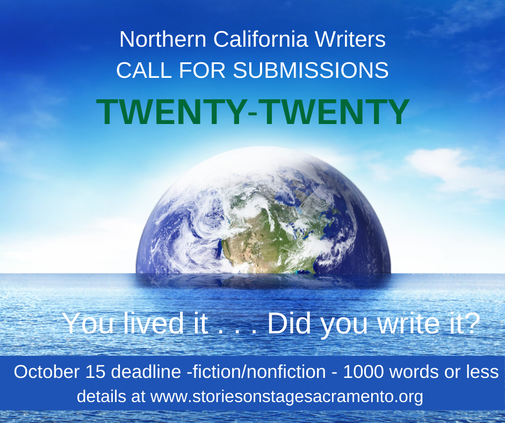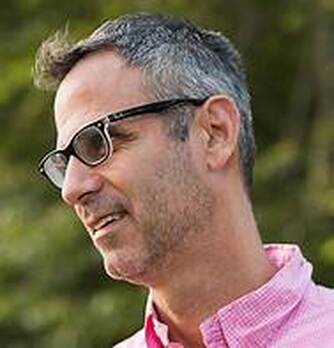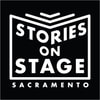 For this month's Stories on Stage Sacramento interview, Sue Staats chats with Dorothy Rice, Stories' co-director and editor of the recently released anthology: Twenty Twenty - 43 Stories From a Year Like no Other. 7 stories from the anthology will be performed Friday, July 23, 5:00 pm PST, live on zoom. Actors Brennan Villados and Kelley Ogden will perform stories by authors Dev Berger, Deborah Meltvedt, Pam Houston, Sands Hall, Anita Felicelli, p joshua laskey and Joshua Mohr. Register today, and order a copy or three of the first anthology from Stories on Stage Sacramento! SUE: it’s not just “oh, we have a barn let’s do a play.” It just doesn’t magically appear, I know that. Let’s go back to the beginning. What was the initial spark that made us all think about doing an anthology? About when did this happen? DOROTHY: Well, I’m thinking it would have been summer 2020. There were a couple of different threads as to how it came up. I was doing some free writing on Zoom with different groups (yeah, Team Haag) and finding that the things I was writing about were different from what I was writing pre-pandemic. The result of being house-bound, more introspective, and thinking about the value of things, the meaning of life, those what’s-it-all-about kinds of questions. Some amazing writing was happening in free-writing groups, writing that felt important to capture. The other thread all four of us had (meaning Dorothy, Shelley Blanton-Stroud, Sue and Jessica Laskey) was that it was an unusual year for Stories on Stage and we talked about different ways we might connect with the people who have been loyal followers, folks who love books, many of whom are writers. Out of that came the idea for a submission call, for writing from the year 2020, and leaving it pretty open—anything but poetry. We didn't know what would be submitted of course, but the stories showed up in our email in-box. From there we had the idea of inviting authors who had been featured at Stories on Stage to have work featured in the anthology.  SUE: So, there was actually no grand plan. We really had no idea of how to actually make a book (laughs)? DOROTHY: (laughs) SUE: We just threw it out there and said, send us writing? DOROTHY: Yes, though we all had different levels of experience and knowledge of publishing. Jessica had done an anthology before. I’d worked with two small presses and seen how that went, and Shelley worked with She Writes Press on Copy Boy. I had also recently done my own e-book conversion of Gray is the New Black and found that that was pretty straightforward, with the online tools for formatting and publishing. A few conversations with local publisher Anara Guard (New Wind, an independent publisher) were super helpful. We talked about her experience as a publisher and the different routes for printing and distribution and the tools companies offer. Based on that, we went with Ingram. The one place we knew we wanted professional help was in design, so we hired local multi-media artist Angela Caldwell for cover and interior design. Publishing has changed so much; anything goes, right? People are self-publishing, there are many small and micro presses, and there are websites and applications to do all the formatting. It didn’t seem like an insurmountable task. We knew the stories were out there, and believed it would be worthwhile to capture some of them in print. Also, SOSS has a wonderful history and it seemed a fitting way to celebrate the ten-year mark, and also to discover if an anthology is something we want to do more frequently—every three years, or five years perhaps, as a lasting, physical object that comes out all of this volunteer effort. It’s a lot of work! SUE: It is. And you know, I thought about it for a long time and knew that on top of doing everything for the events—given the structure of Stories on Stage for its first ten years—I didn’t think producing an anthology was really possible. But the structure change that you’ve done in the past two years made it possible. And also the extraordinary circumstances of 2020 that threw a theme into our laps. DOROTHY: Yes, it opened up some ideas that we hadn’t been thinking about before, as a group. Remember? We talked about different ways to connect with an audience since we couldn't do live events in a theater setting. As a new nonprofit we were applying for grants. We brainstormed about holding a workshop/conference. We were throwing ideas at the wall and seeing what would stick. The anthology stuck. In retrospect, I’m glad it’s the anthology that stuck, and not the two-day conference! SUE: Yes. This gives us a product, a lasting artifact. DOROTHY: Right. SUE: So that’s how the idea was born. And then, we put out a call for entries. Tell me about the response, and if it surprised you. DOROTHY: It didn’t surprise me. Narrowing it down to those we chose was difficult, then working with authors to edit the stories. The editing process was a good experience for me, and I hope it was a good experience for the writers I worked with as well. What was super gratifying, was the generous response from some of our prior featured authors. Several of these amazing, well-published authors gave us work that hadn't previously been published—Sands Hall, Anita Felliceli, Joshua Mohr and Joan Frank to name a few. SUE: Wow. That’s amazing. I didn’t know that. It speaks well for how, by treating writers well and giving them a forum, Stories on Stage Sacramento has become of value to writers. I mean, the willingness to share a piece for an anthology that’s not going to pay you anything…. So, now it’s November or so, and we have closed submissions and have all these stories. And then we read them and select them. And then what? For me, the next step is completely unknown territory. So what was your next step? DOROTHY: Then I began to work individually with the authors, and it ran the gamut, from virtually no work to a fair amount of editing, including developmental or fleshing out types of changes, additions and deletions. SUE: Give me an example of working with a writer and how you developed the story together and what you learned. DOROTHY: Well, one that is easy to talk about is the one that takes the point of view of the virus (All in the Family, by Patti Santucci) that wound up in the Monsters section. I loved the voice right off the bat, but I didn’t get it. I had to have it pointed out to me that it was from the point of view of the virus, and so my perspective was, this is a little bit too vague. So in that case I initially gave the writer my thoughts, that we really loved the idea but I wanted to work with her on ways to keep the subtlety she wanted but to also make it so that readers wouldn't remain befuddled after reading it more than once. It was a negotiation. She wanted to err on the side of mystery, and I wanted to honor that artistic preference, but I also didn't want the reader unable to make sense of the story. Making readers think, and ask themselves questions, is great; not providing the clues, the breadcrumbs needed to eventually put it together, is not necessarily so great. It’s subjective of course, so it was a matter of compromise. I feel good about the work we did together, and Patti's cool story, which is unique and unlike anything else in the anthology. SUE: So, you worked like this with a number of the writers in the book, and spent a lot of time on it. And while you were whipping the stories into shape, were you at the same time seeking out how to get these stories from individual files into a book? And were you also working with the designer. This is something I know nothing about. Tell me about the nuts and bolts of publishing. Once you have the work, then what? What was the best way for Stories on Stage to publish, and how did you decide that? DOROTHY: First of all, I used Scrivener (Scrivener is a word-processing program and a set of organization tools designed for authors) so that I could put all the stories into one document and move them around, format and organize them under the five headings. Angela Caldwell-Tannehill designed our beautiful cover and did the interior design as well; she converted the document into the proper format for the printer, in this case Ingram. SUE: I thought Ingram was just a distributor to booksellers. I didn’t know they also wers a printer. Tell me about that. DOROTHY: My impression is that Ingram, and other companies like them, can do many things, including design, printing and distribution. For our purposes, I didn't want to be mailing out books and handling payments. We knew we wanted to work with Capital Books as a primary bookseller; bookstores are accustomed to working with Ingram, so that relationship got us out of being a middle-person, so to speak.  SUE: Will we get royalties? DOROTHY: We will, though it may take some time to offset the costs of design, printing and Ingram's ancillary costs. Each writer in the book got a free copy, which we paid for. So at this point I don’t know whether we will break even, lose money, or make money. Which is why the generous donations we received recently are so important—donations literally enabled us to publish this anthology. SUE: Everyone needs to buy a copy, and another for a friend! DOROTHY: Absolutely! SUE: So, is Stories on Stage Sacramento considered the publisher? DOROTHY: We have published this book, yes! SUE: So, you’ve got the stories, the designer, the printer, Capital Books, and there’s six months between that and the June 30 publication date. There were many decisions to be made, and one of the most interesting to me is how—and why—you divided it into themed sections (Masks, Resilience, Monsters, Kinship and Time). DOROTHY: Perhaps it came out of deciding what I didn't want to do, like arrange the stories alphabetically or by topic—Covid, wildfires, whatever. I also wanted to visually acknowledge the generous contributions of the authors who's work we'd solicited, without diminishing the local authors who responded to our submission call. By using the thematic categories to group stories, we have "lead" stories from our guest authors at the beginning of each section, distributed throughout the anthology. I also didn’t want the section topics to read like the newspaper headlines. I believe the idea for the monsters category came first. I read Anita Felicelli’s amazing story Mother, My Monster and that got me thinking. 2020 was a year full of monsters, literally and figuratively. The virus, virulent racism, politics, fire. The categories allowed me to group stories in ways that seemed more thought provoking or evocative than trite or pro forma. SUE: Stories on Stage Sacramento has a long tradition of, in their live events, featuring an “established” writer with an “emerging” writer. So you’ve kind of done the same thing, with how you’ve arranged the stories in the anthology. I think all the writers will be thrilled. DOROTHY: The stories of our featured “name” writers fit naturally at the beginning of the sections. For example, Karen Bender’s story, The Shame Exchange, in which people actually do have to wear masks, fit perfectly at the beginning of the Masks section, Mother, My Monster for the Monsters section, Pam Houston's Stamina (Memorial Day Weekend, 2020) for the Resilience section, etc. SUE: So now that Stories on Stage Sacramento has published its first book—and thinking down the road, toward the possibility of another—what would you do differently? DOROTHY: I think including original artwork would be cool. Perhaps we could put out a call for art in addition to stories. SUE: Well, it looks great. The mix of well known writers with lesser known ones could be a signature of what Stories on Stage publishes, and something to think about, looking forward to the next anthology. DOROTHY: It should be. That’s the tradition Stories on Stage has had from the beginning. And also, it supports our writing community. For some of these authors, the anthology is a first publication, or one of few. I love that. SUE: I do too. I have one final question. Why do you think this anthology, and the writing from this time, is so important? DOROTHY: 2020 was a year to chronicle, for many reasons. There were so many complex things overlapping that it felt like a year with calamities of biblical proportions. At the same time a lot of beauty and grace came out of it, people helping one another and becoming aware of things they hadn’t thought they needed to think about, like systemic racism, and the way Covid impacted communities disparately because of structural privilege. In the suburbs we barely saw it, while in urban communities of color in this country and around the world people were dying in the hundreds. Thinking uncomfortable thoughts, waking up to uncomfortable truths, takes us out of our bubbles. We see the suffering of others, whether it’s the wildfires, the pandemic, the murder of George Floyd, the ugly, inciting rhetoric during the election season, all of it happening concurrently. I imagine many anthologies, novels, poetry and other writing will come out of this year. SUE: I was so intrigued by how different everyone’s focus is; with all the things going on, everyone chose something different to write about. The expanse and variety of stories is impressive, and the wide variety of different stories. DOROTHY: I think we did good. It’s something we can all be proud of—the authors, and Stories on Stage Sacramento. SUE: Would you do it again? DOROTHY: Yes, but not anytime soon.
Late Peaches: Poems by Sacramento Poets, Sacramento Voices, and others. She earned an MFA from Pacific University, and was a finalist for the Gulf Coast Prize in Fiction and the Nisqually Prize in Fiction. Her stories have been performed at Stories on Stage Sacramento and Stories on Stage Davis, and at the SF Bay-area reading series “Why There Are Words.”
0 Comments
Leave a Reply. |
|
Who We AreLiterature. Live!
Stories on Stage Sacramento is an award-winning, nonprofit literary performance series featuring stories by local, national and international authors performed aloud by professional actors. Designated as Best of the City 2019 by Sactown Magazine and Best Virtual Music or Entertainment Experience of 2021 by Sacramento Magazine. |
|




 RSS Feed
RSS Feed
